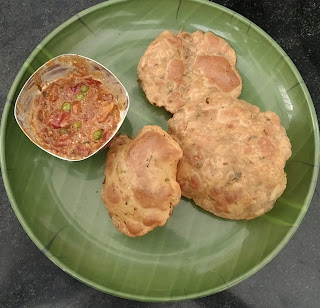While I may not be sweet-toothed, I am surrounded by many who are and times I too feel like treating my sweet taste budz. This diwali, I chose to make Jalebis - those yellow, thin, crispy ones. And then there are those Jangris - those orange, bit thicker, softer ones.
Jalebis are made using all purpose flour, will have a slight tangy taste, and the flour is fermented overnight before preparation. Jangris are made using uradh dhal and fried gram dhal flour, and is neither tangy nor fermented.
Wonder why I started with mentioning both that's because my dish was a hybrid of both named as "JalJangebis" ;)
I used Uradh Dhal and rice flour - ideally output should have been jangri. But given the shape, color and crispiness it was like jalebis -- end of it all, this hybrid sweet "jaljangebis" was also a roaring success :)
Ingredients:
Method
To make the flour:
Jalebis are made using all purpose flour, will have a slight tangy taste, and the flour is fermented overnight before preparation. Jangris are made using uradh dhal and fried gram dhal flour, and is neither tangy nor fermented.
Wonder why I started with mentioning both that's because my dish was a hybrid of both named as "JalJangebis" ;)
I used Uradh Dhal and rice flour - ideally output should have been jangri. But given the shape, color and crispiness it was like jalebis -- end of it all, this hybrid sweet "jaljangebis" was also a roaring success :)
- Uradh dal - 2 cups
- Raw Rice - 1/4 cup
- Sugar - 500 gms (as per your taste you can add or reduce this)
- Oil - To Fry
- Lemon yellow - 1/2 tspn food color (this will give the light yellowish orangish shade)
- Saffron - some use this
Method
To make the flour:
- Soak uradh dal and raw rice for an hour. Grind both separately to a smooth batter till they become frothy. Consistency should be that of dosa flour
- Mix them and allow it to rest for 30 mts
To make the sugar syrup:
- In a non stick pan, add sugar and 1-1.5 cups of water. Cook it on medium flame
- Add 2 tspn of milk to remove any froth due to sugar (you can remove the froth as it floats up)
- The sugar syrup starts condensing and should be One String. Switch off the flame.
- Add a lemon wedge to retain the consistency of the sugar syrup and disable any crystalization later.
- Sugar Syrup should be left on the gas to retain the heat
To make the jaljangebis / jangris:
- In a kadai, heat oil. You can test the readiness by dropping a small ball of the batter inside. It should pop up immediately.
- Fill the jalebi maker with the batter. Alternatively, you can use a cloth or a milk cover with a small hole on one of its corner and make them.
- Make the desired shape... jangris and jalebis differ in shape but whichever comes easier for you go for it
- Allow it to fry to golden brown on both sides by turning them
- Remove from fire ensuring no excess oil and dip it directly into the sugar syrup. Ensure sugar syrup is warm to hot when you dip it
- Allow it to stay each side for 1.5 mts and remove it to a vessel (overall 3 mts).
- As it cools down, you can pack it in air-tight container.
















